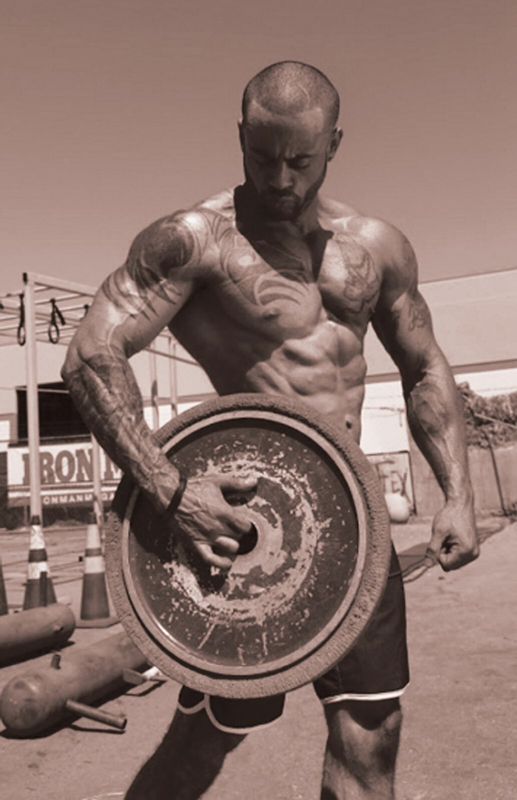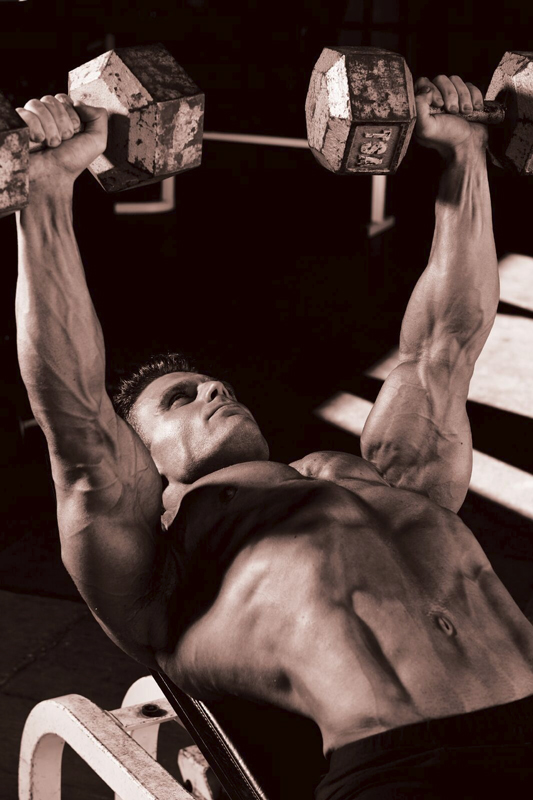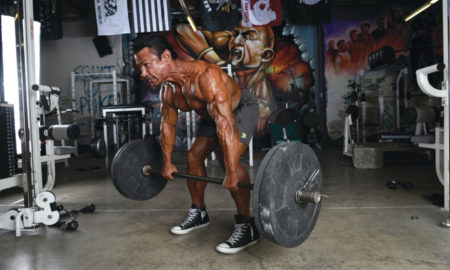

Add size and definition to your chest with this next level chest workout.
By Raphael Konforti MS, CPT
History tells us Spartans were battle-hardened warriors with abs and chests that appeared to be chiseled out of granite. They were fit combatants with the kind of grit and determination that has ensured their unique place in history. To this day, men aspire to be like them. But, to accomplish that, you need to accept that when it comes to your training, no day is more sacred than chest day. After all, there’s no muscle that distinguishes masculinity more than a prominent, bold and defined chest.
If you want your chest to stand out, you need to do more than just the bench press on Mondays. You need a well-rounded workout that takes advantage of the anatomy and mechanics of your chest. Not sure how to accomplish that? This chest workout checks all of those boxes and takes it a step further. How? By implementing an array of techniques and rep ranges to ensure maximal hypertrophy. Build yourself a Spartan chest with this workout for the ages!
Training Based On Chest Anatomy
The exercises in this workout were carefully selected based on how the pectoral or chest muscles function. The pecs have two main functions: Arm extension and adduction. Basically, your chest can extend your arms away from your body like a bench press and bring your arms together like a hug or flye motion.
The pecs are a fan-shaped muscle, meaning that the muscle fibers are not all pointed in the same direction, so movements that vary the angles of force work best. That’s why you’ll primarily use dumbbell presses instead of barbell or machine presses. Not only do the dumbbells allow for a greater range of motion, but, by coming together at the top, you’ll be getting the arm adduction motion that machines and barbells lack.
Using Rep Ranges And Rest
This workout will be kicked off with incline dumbbell presses in the six to eight rep range. These reps will help improve your strength, enabling you to lift more and more as the weeks pass. It’s important when performing lower reps to rest sufficiently. Aim for two minutes between sets to give your muscles time to regenerate ATP or stored energy to move as much weight as possible. Even better than the fact that you’ll be building strength, low reps are proven to increase testosterone levels.
The rest of the workout will use moderate to high reps ranging from 10 to 15 reps and more. Higher reps first and foremost increase time under tension – a key component to stimulating hypertrophy. To ensure maximal time under tension, these exercises should be done with a moderate and controlled pace. Keep the focus on the tension, not the amount of weight. Maintaining a consistent tempo is especially important when supersetting the cable press crossover and cable flye. If done correctly, this superset will last almost two minutes. Rest should be kept to a minimal amount of time (45 to 60 seconds), just enough to move a respectable weight. You’ll need to start these sets before you feel completely rested, even if you’re not able to lift as much as possible. These reps are about hypertrophy not strength, so you’ll need to check your ego. The reward you get in return for checking your ego is a boost in growth hormone brought on by the shortened rest periods.
Bringing The Intensity: Post-Exhaust Superset
Typically, high reps and short rest are enough for most people. However, doing what most people do will only generate what most people achieve: Average results. Don’t settle for average! To break beyond average, you need to do what most people are not willing to do and that’s where the post-exhaust superset comes in. You’re most likely familiar with part of that name: Supersets (performing two exercises back to back with no rest). The other portion, the post-exhaust technique, was made famous as a result of its ability to isolate and train a specific muscle to failure.
The post-exhaust technique works by first using a compound exercise like the cable press crossover then moving to an isolation exercise like cable flyes to finish off the muscle group. It works so well because the compound exercise allows you to lift more weight yet still target a specific muscle. Then the isolation exercise ensures that the specific muscle reaches failure as opposed to the accessory muscles.
In this workout, the cable press targets your chest, but also uses your triceps and shoulders. Failure on the press could be caused by your triceps and shoulders, as opposed to your chest. By isolating your chest afterwards with cable flyes you know your chest is hitting failure and not being held back by your triceps or shoulders.
The superset takes all of this even further because your chest will have no time to recover before being taken to complete failure. Remember that higher reps, and especially this superset, are not about the weight being used, but about the quality of the rep and contraction of your muscle. Don’t be discouraged if you use less weight than normal. Your chest is being put through a huge amount of stress in this workout.

Raising The Intensity: Reverse Pyramid Reps
For many, the standard structure of this workout presents enough of a challenge and stimulus to leave you struggling to lift your arms to wash your hair. For those with several years of training experience under their belts that can handle a higher intensity we have you covered. Take the intensity up by using a reverse pyramid rep scheme instead of just aiming to hit the six to eight reps on the incline dumbbell press. The reverse pyramid rep scheme is extremely taxing, both on the nervous system and muscles.
Before attempting the reverse pyramid, make sure you’re properly warmed up because the first set is the heaviest. Normally you’d build up to your heaviest weight and drop the reps as you go. Here you’ll do the opposite. The first set will be the heaviest weight you can handle for six to eight reps. Then you’ll decrease the weight by 2.5 to 5 percent and again hit six to eight reps. You’ll repeat this drop in weight for the last set still performing six to eight reps.
This method ensures that you are truly using the maximum amount of weight on each set, thoroughly fatiguing your chest. If you’re not used to this method, it may take one to two weeks to figure out what weight to use. Once you have the weight for the first set down, you’ll be able to clearly track progress and know to increase the weight if you hit more than eight reps. Using the reverse pyramid won’t only be making you consistently stronger, it’ll save you from the ongoing guesswork of what weight to use so you can get to work in the gym.
The Finisher: Bench Press 21s
It’s a fact: 21s aren’t just for blackjack and biceps. To cash out of this workout, you’re going to need to stay mentally strong. Your chest will already be pumping from the post-exhaust superset, but you’ll only need to last two more sets. Bench press 21s will focus on the lower half of the rep, the upper half of the rep and then the complete range of motion. Completing 21 reps, even if 14 of them are only half reps, is no joke. Start light (no more than 50 percent of your one-rep max) and have a spotter.
Although it’s the finisher, resist the urge to blow through these reps as fast as possible. Time under tension is your friend and the ultimate determiner of the training response. Take each rep slow – at least one second down and one second up – and avoid pausing between any reps. Do that and you’ve made it through the gauntlet!
Programming The Workout
Expect soreness after completing this workout for the first time. Not the kind of soreness where you only remember on a couple of occasions that you trained your chest earlier that day. The kind of soreness where it’s impossible to forget you trained your chest.
Experienced lifters can pull off this workout twice a week as long as they’re not in a severe calorie deficit. Otherwise once per week is plenty enough. Your body will need time to fully recover so you can come back stronger and bigger. As with any new workout, start slow and progress. Be sure that you are tracking your progress along the way.
EXERCISE SET REPS
1. Incline Dumbbell Press 3 6-8 (Reverse Pyramid)
2. Dumbbell Bench Press 3 10
3a. Cable Press Crossover 4 12
3b. Cable Flye 4 15
4. Bench Press 21s 2 21
Incline Dumbbell Press
Set a bench to 45 degrees. Place a dumbbell on each thigh. One leg at a time, lift each dumbbell up to your chest. Keep your elbows slightly tucked in and then lower them at a controlled pace while inhaling. Lower the dumbbells until they reach chest height. Exhale and press the dumbbells back to the starting position.

Dumbbell Bench Press
Dumbbell Bench Press
Sit on a bench resting a dumbbell on each thigh. Lie back on the bench using your legs to lift the dumbbells above your chest. Keeping your elbows slightly tucked in, lower the dumbbells to your chest while inhaling. Exhale and press the dumbbells back to the starting position.
Cable Press Crossover
Set the cables so that they are secured at chest height. Grab each handle and take a small step forward. Bring each handle in front of your elbows so you are in a standing push-up position. Keeping your elbows directly behind the handles, press both handles out and cross one handle over the other at the end range of motion. Be sure to contract your chest and exhale. Slowly bring the cables back to the starting position. Repeat the motion alternating which handle stacks on top.
Cable Flye
Set the cables so that they are secured at chest height. Grab each handle and take a small step forward so that your arms are extended and there’s tension on the cables. Keeping your elbows extended, exhale and bring the cables together directly in front of your chest. Be sure to keep your elbows slightly lower than shoulder height and contract your chest throughout. Slowly bring the cables back to the starting position.
Bench Press 21s
Set up as normal for the bench press with your feet firmly planted on the ground, a slight arch in your lower back and keeping your elbows directly underneath the bar. Lower the bar all the way to your chest. Press the bar up only halfway and then lower it back to your chest. Repeat this range of motion for seven reps. Then press the bar all the way. Lower the bar only halfway down and press it all the way up. Repeat this range of motion for seven reps. Finish the final seven reps using a full range of motion.






















You must be logged in to post a comment Login